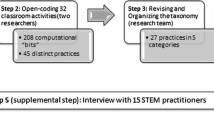Abstract
What happens when mathematics students are invited to ask questions and make observations about the way discourse works in their classroom? This article describes my extended conversation with a high school mathematics class about a phenomenon that caught the attention of two girls in the class. Together we observed and reflected on the direction of one’s gaze during mathematics conversations. This discussion came about while I co-taught this class, prompting the students daily to become more aware of their language practices in class. This critical language awareness effort aimed to address inequities in power relations within the classroom discourse by inviting student perspectives and resulted in drawing two students’ attention to the power of symbols.
Résumé
Que se passe-t-il lorsque les étudiants de mathématiques sont invités à poser des questions et à faire des observations sur le fonctionnement du discours dans leurs cours ? Cet article analyse une longue conversation que j’ai eue avec les élèves d’un cours de mathématiques au secondaire, au sujet d’un phénomène qui a attiré l’attention de deux étudiants en particulier. Ensemble nous avons réfléchi sur la question du regard des participants lors de conversations qui traitent de mathématiques. La question a été soulevée pendant que j’enseignais à ce groupe en collaboration avec un autre professeur et que j’encourageais quotidiennement les étudiants à prendre conscience de leurs pratiques de discours en classe. Cet effort de «réflexion critique sur la conscience du discours» visait à faire aborder la question de l’iniquité des rapports de pouvoir dans le discours en classe en invitant les étudiant à exprimer leur point de vue, ce qui a attiré l’attention de deux étudiants sur le pouvoir des symboles.
Similar content being viewed by others
References
Adler, J. (2001). Teaching mathematics in multilingual classrooms. Dordrecht, The Netherlands: Kluwer.
Bakhtin, M. (1986). The problem of speech genres (V. McGee, Trans.). In C. Emerson & M. Holquist (Eds.), Speech genres and other late essays (pp. 60–102). Austin, TX: University of Texas Press. (Original work published 1953)
Brown, T. (2001). Mathematics education and language: Interpreting hermeneutics and post-structuralism (revised 2nd ed.). Dordrecht, The Netherlands: Kluwer.
Chouliaraki, L., & Fairclough, N. (1999). Discourse in late modernity: Rethinking critical discourse analysis. Edinburgh, Scotland: Edinburgh University Press.
Cobb, P., Wood, T., Yackel, E., & McNeal, B. (1992). Characteristicsofclassroom mathematics traditions:Aninteractional analysis. American Educational Research Journal, 29(3), 573–604.
Duval, R. (1999). Representation, vision and visualization: Cognitive functions in mathematical thinking. Basic issues for learning. In F. Hitt & M. Santos (Eds.), Proceedings of the 21st Annual Meeting of the North American Chapter of the International Group for the Psychology of Mathematics Education (pp. 3–26). Cuernavaca, Mexico.
Fairclough, N. (Ed.). (1992). Critical language awareness. London, England: Longman.
Gordon Calvert, L. (2001). Mathematical conversations within the practice of mathematics. New York, NY: Peter Lang.
Gutierrez, R. (2011). How should we conceptualize equity in mathematics education research? In B. Herbel-Eisenmann, J. Choppin, D. Pimm, & D. Wagner (Eds.), Equity in discourse for mathematics education: Theories, practices, and policies. New York, NY: Springer.
Herbel-Eisenmann, B., & Wagner, D. (2010). Appraising lexical bundles in mathematics classroom discourse: Obligation and choice. Educational Studies in Mathematics, 75(1), 43–63.
Kress, G. (1990). Critical discourse analysis. Annual Review of Applied Linguistics, 11, 84–99.
Kress, G. (1993). Against arbitrariness: The social production of the sign as a foundational issue in critical discourse analysis. Discourse and Society, 4(2), 169–191.
Larson, G. (1989). The prehistory of The Far Side: A 10th anniversary exhibit. Kansas City, MO: Andrews and McMeel.
Lave, J., & Wenger, E. (1991). Situated learning: Legitimate peripheral participation. Cambridge, England: Cambridge University Press.
Levinson, S. (1983). Pragmatics. New York, NY: Cambridge University Press.
Lyons, J. (1977). Semantics (Vol. 2). London, England: Cambridge University Press.
Mason, J. (1998). Enabling teachers to be real teachers: Necessary levels of awareness and structure of attention. Journal of Mathematics Teacher Education, 1(3), 243–267.
Morgan, C. (1998). Writing mathematically: The discourse of investigation. London, England: Falmer.
Piaget, J. (1971). Structuralism. London, England: Routledge.
Radford, L. (2002). The seen, the spoken and the written: A semiotic approach to the problem of objectification of mathematical knowledge. For the Learning of Mathematics, 22(2), 14–23.
Rowland, T. (2000). The pragmatics of mathematics education: Vagueness in mathematical discourse. London, England: Falmer.
Sfard, A. (2000). Symbolizing mathematical reality into being—Or how mathematical discourse and mathematical objects create each other. In P. Cobb, E. Yackel, & K. McClain (Eds.), Symbolizing and communicating in mathematics classrooms (pp. 37–98). Mahwah, NJ: Lawrence Erlbaum.
Skovsmose, O., & Borba, M. (2000). Research methodology and critical mathematics education. Roskilde, Denmark: Centre for Research in Learning Mathematics, Roskilde University.
Wagner, D. (2003). Students and teachers listening to themselves: Language awareness in the mathematics classroom. In N. Pateman, B. Dougherty, & J. Zilliox (Eds.), Proceedings of the 27th Conference of the International Group for the Psychology of Mathematics Education held jointly with the 25th Conference of PME-NA (pp. 355–362). Honolulu, HI.
Wagner, D. (2007). Students’ critical awareness of voice and agency in mathematics classroom discourse. Mathematical Thinking and Learning, 9(1), 31–50.
Wagner, D. (2008). “Just go”: mathematics students’ critical awareness of routine procedure. Canadian Journal of Science, Mathematics and Technology Education, 8(1), 35–48.
Author information
Authors and Affiliations
Corresponding author
Rights and permissions
About this article
Cite this article
Wagner, D. Facing the Mathematics: Students’ Critical Awareness of the Elusiveness of Mathematical Objects. Can J Sci Math Techn 11, 292–305 (2011). https://doi.org/10.1080/14926156.2011.595985
Published:
Issue Date:
DOI: https://doi.org/10.1080/14926156.2011.595985




